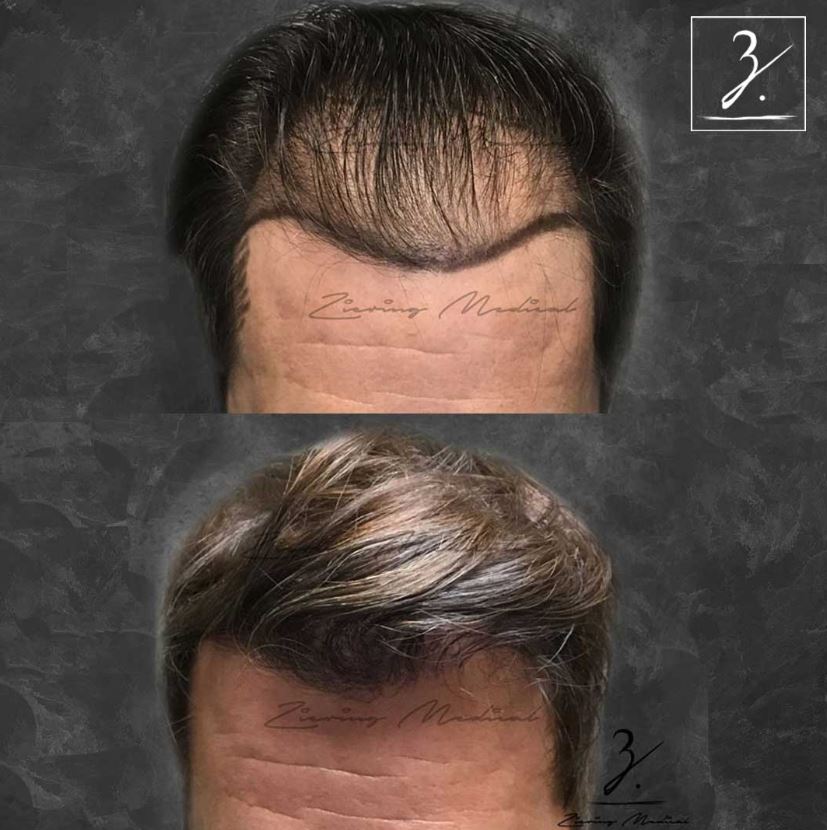Hair Transplant Recovery: What to Expect (With Real Results)

How long does hair transplant recovery take? Hair transplant recovery takes time, and it’s normal to wonder what’s ahead. Most patients heal within 10–14 days, but visible results take months. In the first week, you’ll see redness, scabbing, and possibly some shedding. That’s expected. By month three, new hair starts to grow. By month twelve, you’ll likely see your full results.
In this hair transplant recovery guide, we will cover the recovery timeline week by week and month by month, so you know what to expect and how to take care of your grafts at every stage. Whether you have FUE or FUT, this guide will help you heal right and get the best possible results.
Hair Transplant Recovery Timeline at a Glance
Here’s a quick overview of what to expect after a hair transplant. Healing is front-loaded in the first two weeks, but hair growth can take time.
| Timeline | What to Expect |
| Days 1–2 | Redness, swelling, and tenderness. Avoid touching your grafts or scalp. |
| Days 3–4 | Scabbing begins. You may be instructed to gently wash your scalp. |
| Days 5–7 | Crusting, itchiness. Some early shedding may start. No scratching. |
| Week 2 | Scabs fall off. Shedding increases. Redness may persist. |
| 1–3 Months | Most transplanted hairs shed. Follicles enter the resting phase. No visible growth. |
| 3–6 Months | Thin, wispy new hairs appear. Growth may be uneven or patchy. |
| 6–9 Months | Hair thickens. Density improves. Results become more noticeable. |
| 9–12 Months | Most patients see strong, visible growth. Hairline fills in. |
| 12–18 Months | Final result. Hair transplant fully matures and blends with native hair. |
Hair Transplant After 1 Week
Healing and Symptoms
- Redness and swelling around the recipient and donor areas are normal.
- Mild discomfort, tightness, or itching may develop by day 3–4.
- Scabs begin forming around grafts by day 4–5.
- By day 7, many scabs will start falling off naturally.
Washing & Aftercare
- Most patients are cleared to wash their scalp gently around day 3–4.
- Use lukewarm water and a mild, non-abrasive shampoo.
- Pour water gently. Don’t rub or scrub. Pat dry with a clean towel or air dry.
- Continue daily washes to soften scabs and keep the area clean.
What Not to Do
- Don’t scratch, pick scabs, or touch the grafts.
- Avoid hats, helmets, sun exposure, and heavy exercise.
- No smoking or alcohol. Both can slow healing.
- Sleep with your head elevated to reduce swelling.
Hair Transplant After 2 Weeks
Healing and Symptoms
- Most scabs should fall off naturally by the end of the second week.
- The scalp may still look pink or slightly red, especially in fair-skinned patients.
- Some transplanted hairs will begin to shed. This is called “shock loss” and it’s normal.
- Shedding typically starts around day 10–14. This shedding phase is part of the telogen phase of the hair cycle.
What Not to Do
- No picking at leftover scabs. Let them come off naturally.
- Avoid intense physical activity until your surgeon gives the go-ahead.
- Still no swimming, saunas, or direct sun exposure.
What You Can Do
- Resume gentle daily washing as normal.
- You may start sleeping in your usual position.
- Light activity is usually fine. Just avoid anything that causes sweating or strain on the scalp.
FUE vs. FUT Recovery: What’s the Difference?
Your recovery experience depends on the type of hair transplant you had, whether it’s FUE or MDEE/strip FUT. Both follow the same healing timeline in the recipient area: redness, swelling, scabbing, shedding, and full regrowth over 9–12 months.
The main difference is the healing in the donor area. FUE typically heals faster with tiny dot scars and less discomfort because it does not require removing a thin strip of scalp from the donor area. On the other hand, FUT involves a linear incision that takes longer to heal and may be more tender early on, but it allows more grafts in one session.
Hair Transplant After 1 Month
By one month, most of your transplanted hairs will have shed. This is not a reason to panic. The follicles are still alive, but they’ve entered the resting (telogen) phase. The scalp might look patchy or like it did before the procedure. Some native hairs may also thin due to temporary shock loss.
The donor area should be fully healed. Redness may linger in lighter skin tones. This stage can feel like nothing’s happening, but it’s part of the process. New growth starts soon. If you notice signs of infection, redness that spreads, pus, or worsening pain, call your surgeon immediately.
Hair Transplant After 2 Months
In two months, the surface has healed, but the grafts are still in recovery. The donor area should be fully healed, and any lingering redness in the recipient area is normal. Most hairs are still in the resting phase, so visible growth is minimal.
You might see a few soft, thin hairs breaking through, but full regrowth hasn’t started yet. Stay consistent with aftercare and avoid anything that puts pressure on the scalp. This phase is about healing, not results.
Hair Transplant After 3 Months
At three months, new hairs usually start to emerge. They’ll look thin, soft, and uneven. This is the first sign the grafts are settling. Growth won’t be uniform, and some areas may still look patchy.
The donor area should feel completely healed by now, and the recipient area should show no visible signs of the procedure. It’s still early, so don’t expect density or definition yet. Just keep going. This is where the progress starts.
Hair Transplant After 4–6 Months
Between months 4 and 6, growth becomes more noticeable. Hairs that started growing in month 3 will begin to thicken and darken. New follicles continue to activate, so coverage improves, but density is still developing.
You may notice uneven growth as some areas fill in faster than others. That’s expected. The texture of your new hair may feel different at first, but it will normalize over time. At this point, most patients feel confident styling their hair again, even if the final result isn’t fully in yet.

3113 Follicular Units, 1 MDEE/FUT Hair Transplant, 5 Months Post Op
Hair Transplant After 6–9 Months
This is when most patients see major progress. Hair becomes thicker, darker, and more consistent across the scalp. Density improves, and patchiness starts to even out. You can cut and style your hair normally. While you’re close to your final result, the hair is still maturing. Some follicles are still catching up, so expect continued improvement in texture and fullness over the next few months.

3250 Follicular Units, 1 MDEE/FUT Hair Transplant, 6 Months Post-Op
Hair Transplant After 9–12 Months
By 9 to 12 months, most of the growth is complete. Your hair should look fuller, more even, and natural. Texture, density, and coverage continue to improve as the last few follicles mature. You can treat your hair like normal. For many, this is the point where the transplant result feels complete. If your hair is still maturing, full results may continue into month 18.

2220 Follicular Units, 1 FUE Hair Transplant, 9 Months Post OP
Hair Transplant After 12–18 Months
By 12 to 18 months, your transplant is fully grown in. Hair has reached its final thickness, texture, and density. Any slower-growing follicles will have caught up by now. The hairline should look natural and blend seamlessly with native hair.
At this stage, you can evaluate the full outcome and, if needed, discuss refinements or second sessions with your doctor. Maintenance treatments like finasteride, minoxidil, or PRP can help keep your results long-term.

2031 Follicular Units, 1 FUE Hair Transplant, 12 Months Post-Op

3739 Follicular Units, 1 MDEE/FUT Hair Transplant, 18 Months Post-Op
Hair Transplant Recovery FAQs
What is hair transplant recovery like?
It’s mostly mild and manageable. You’ll feel some tightness, tenderness, and itching in the first few days. The scabs can be uncomfortable, but they clear up quickly with proper washing. Most patients don’t describe it as painful. But you’ll need to be extra careful during the first two as the grafts are still very sensitive.
Can you wear a hat during hair transplant recovery?
Avoid hats for the first 7–10 days. After that, you can wear a loose-fitting one if your surgeon clears it. No tight hats or helmets until fully healed.
How long before I can go back to work after a hair transplant?
Most patients can return to desk jobs within 2–5 days after an FUE transplant. FUT recovery may take closer to 7–10 days. If your work is physically demanding or exposes your scalp to dirt, heat, or friction, allow more time off.
When can I start exercising after a hair transplant?
Light walking is fine after a few days, but avoid heavy lifting, running, swimming, or anything that causes sweating for at least 2 weeks. Always follow your surgeon’s timeline—too much activity too soon can dislodge grafts or slow healing.
Is itching normal during hair transplant recovery?
Yes. Itching is common as the scalp heals, especially around days 4–7. Do not scratch or pick. If it becomes severe, ask your doctor about medicated shampoos or antihistamines.
What shampoo can I use after a hair transplant?
Use a gentle, sulfate-free shampoo for the first few weeks. Avoid anything with harsh chemicals, exfoliants, or strong fragrances until your scalp is fully healed.
Can I smoke or drink alcohol after a hair transplant?
It’s best to avoid both for at least a week before and after your procedure. Smoking restricts blood flow and can affect graft survival. Alcohol can thin your blood and increase swelling.
When can I sleep normally after a hair transplant?
Sleep with your head elevated for the first two weeks to reduce swelling. After that, you can gradually return to your normal sleep position, depending on your surgeon’s advice.
Will people be able to tell I had a hair transplant?
In the first 1–2 weeks, redness and scabbing may be noticeable. After that, the shedding phase begins, and the scalp looks more natural. Most people won’t notice once hair regrows and matures over the next 6–12 months, especially when done by an experienced, board-certified hair transplant surgeon.
